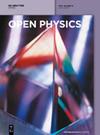Research on optimization of combustor liner structure based on arc-shaped slot hole
IF 1.8
4区 物理与天体物理
Q2 PHYSICS, MULTIDISCIPLINARY
引用次数: 0
Abstract
The flow and heat transfer characteristics of the fluid in the combustor were investigated using numerical simulation in this study. The physical properties of the cooling airflow were fully utilized, and the structure of the combustor was improved. Film hole with novel structure (arc-shaped slot hole) was proposed and compared with cylindrical hole. The optimization schemes for the combustor liner structure were established, in the meanwhile, the influence of different inclinations and slot depths on the temperature distribution of the combustor liner wall was investigated. Compared with the original structure, the average temperature of the target cooling zones in these optimized schemes are reduced by a minimum of 15.12% (227.1 K) and a maximum of 20.65% (351.6 K). A new assessment model (weighted average temperature assessment model) was proposed to provide an effective assessment of the overall cooling effect. The following conclusions were arrived at: high temperature in localized areas is an important reason for the damage of combustor liner wall. Compared to cylindrical hole, the cooling performance of arc-shaped slot hole is better. When the hole type is the same, the larger inclination has higher jet height than the smaller inclination, and the cooling effect is worse. Increasing the slot depth基于弧形槽孔的燃烧器衬板结构优化研究
本研究利用数值模拟对燃烧器内流体的流动和传热特性进行了研究。充分利用了冷却气流的物理特性,并改进了燃烧器的结构。提出了结构新颖的薄膜孔(弧形槽孔),并与圆柱形孔进行了比较。建立了燃烧器内衬结构的优化方案,同时研究了不同倾角和槽深对燃烧器内衬壁温度分布的影响。与原始结构相比,这些优化方案中目标冷却区的平均温度最低降低了 15.12% (227.1 K),最高降低了 20.65% (351.6 K)。为有效评估整体冷却效果,提出了一个新的评估模型(加权平均温度评估模型)。得出以下结论:局部区域温度过高是造成燃烧器衬壁损坏的重要原因。与圆柱孔相比,弧形槽孔的冷却效果更好。在孔型相同的情况下,倾斜度大的喷射高度比倾斜度小的高,冷却效果差。增加槽深 h 可以提高冷却效率。
本文章由计算机程序翻译,如有差异,请以英文原文为准。
求助全文
约1分钟内获得全文
求助全文
来源期刊

Open Physics
PHYSICS, MULTIDISCIPLINARY-
CiteScore
3.20
自引率
5.30%
发文量
82
审稿时长
18 weeks
期刊介绍:
Open Physics is a peer-reviewed, open access, electronic journal devoted to the publication of fundamental research results in all fields of physics. The journal provides the readers with free, instant, and permanent access to all content worldwide; and the authors with extensive promotion of published articles, long-time preservation, language-correction services, no space constraints and immediate publication. Our standard policy requires each paper to be reviewed by at least two Referees and the peer-review process is single-blind.
 求助内容:
求助内容: 应助结果提醒方式:
应助结果提醒方式:


